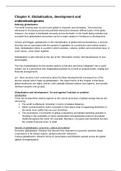Samenvatting
Summary Geographies of Development: Chapter 4 Globalisation, development and underdevelopment
Summary of Chapter 4 'Globalisation, development and underdevelopment' in Geographies of Development written by the authors Potter et al.
[Meer zien]














